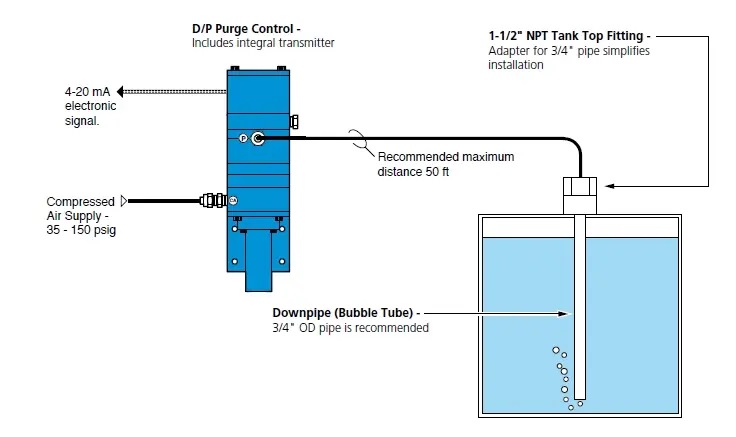
Measuring liquid level in a tank or vessel can be accomplished in a number of ways, all of which require some arrangement of instrumentation to either infer the liquid level through measurement of related physical property or directly deliver the liquid level visually using a scaled gauge arrangement. One indirect method of level measurement, referred to as the bubbler or downpipe method is so named because it employs a purging gas that continually vents from the bottom of a dip tube extending into a tank of liquid. Through a simple apparatus, the level of a liquid can be inferred by the amount of back pressure exerted upon the gas flowing through the tube.
Probably the greatest advantage of this method of liquid level measurement is that the subject liquid does not contact the sensing instrumentation. The only portion of the apparatus in contact with the liquid is a tube immersed in the tank. Selecting the proper material for the immersed tube is left to the user. An additional feature of this method is the entry of the sensing tube from the top of the tank, eliminating the need for a fitting below the liquid-level surface.
Basically, a purge gas flows through the immersion tube and may bubble out the immersed end of the tube, which is open to allow the contained liquid to exert a hydrostatic pressure on the purge gas. The back pressure on the gas that is exerted by the liquid contained within the tank will vary directly with the depth of the liquid. The back pressure can be correlated to a liquid level. Further calculations, which would include the tank shape, dimensions, and liquid density can provide an indication of the volume and mass of the liquid.
It is possible for a user to assemble the components necessary to put a bubbler level indicator into operation, but King-Gage produces a device that consolidates purge control, pressure measurement, level signal transmitter, and necessary connections into a single compact device. There are versions of this level transmitter for electric and pneumatic output signals. They also include an additional level of protection in the form of an internal diaphragm that further isolates the device from the measured medium.
More details, along with some good illustrations, are provided in the document below. Share your process measurement challenges with application specialists, combining your process expertise with their product application knowledge to develop effective solutions.